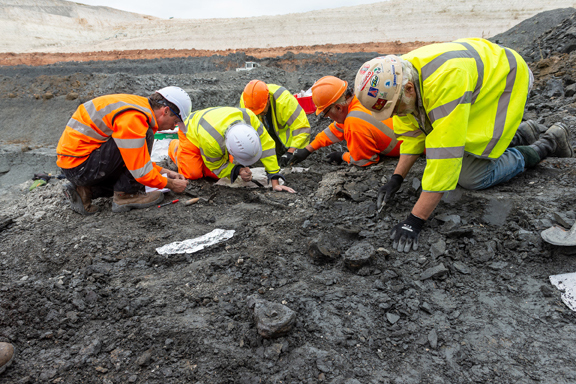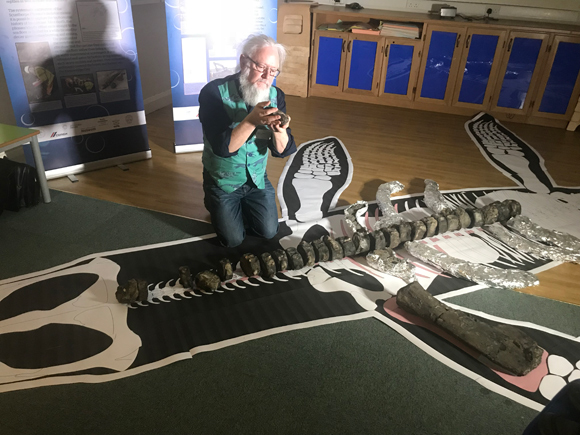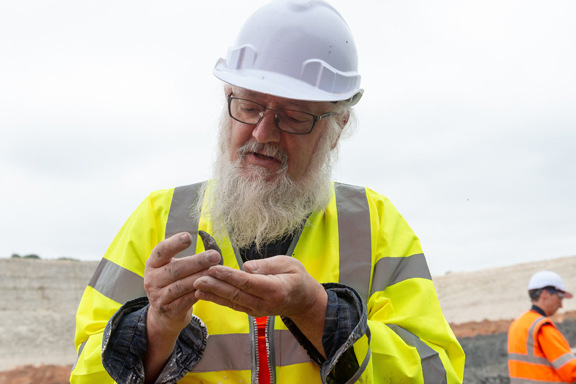Rare Fossils of a North Lincolnshire Pliosaur Go on Display
The “Scunthorpe Pliosaur”
This week has seen the formal unveiling of the fossilised remains of a pliosaur at North Lincolnshire Museum in Scunthorpe. The fossils, consisting of a single tooth, a series of vertebrae, elements from the ribs, the tip of the snout and a single humerus, suggest an animal of around eight metres in length. It would have been one of the apex predators of the Late Jurassic marine environment.
The “Scunthorpe Pliosaur” on Display
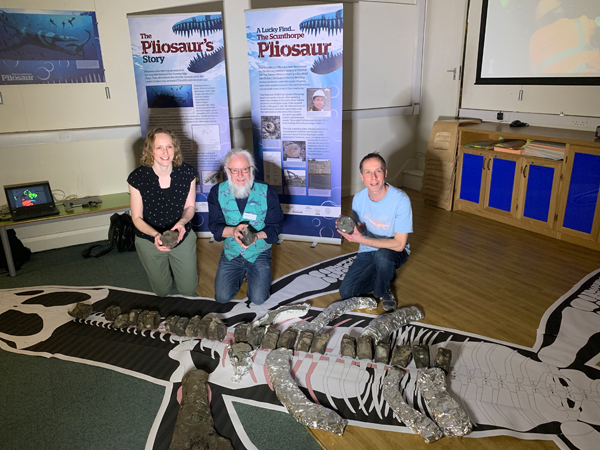
Picture credit: North Lincolnshire Museum
A Memorable Geology Field Trip
The first evidence of the remains of a marine reptile, were discovered by Darren Withers of the Stamford and District Geological Society during a field trip to a north Lincolnshire quarry in October 2017. The Society had visited the quarry previously and were aware that the Kimmeridge Clay deposits (dating from 157 to 152 million years ago), contained numerous fossils, but marine reptile bones, especially several pieces from an individual skeleton are exceptionally rare.
After spending some time looking at the quarry floor, Darren decided to investigate some of the stepped banks in the quarry side. He followed a trail of small Rasenia cymodoce ammonites until they petered out after about thirty metres, but he decided to explore further and then a surprising discovery was made:
Darren commented:
“I’m so glad I did [explore a little further] because the next thing I was looking down at was a large vertebra.”
CEMEX, the quarry owners, granted further access to the site and over the next twelve months or so more of the pliosaur remains were found. In total, the haul consists of twenty-eight vertebrae, a single tooth, fourteen rib elements, a bone from the upper arm (humerus) and some fragments from the front portion of the upper jaw (premaxilla). It has been estimated that the specimen is around 155 million-years-old.
Excavating the Pliosaur Specimen
Picture credit: North Lincolnshire Museum
Pliosaurs were marine reptiles, part of the Plesiosauria Order, specifically, the short-necked plesiosaurs, the Suborder Pliosauroidea. They were the apex predators in most Late Jurassic marine ecosystems. Pliosaurs had an enormously powerful bite, perhaps the most powerful bite of any vertebrate, a complex system of sensory organs in their snouts, superb eyesight and the ability to taste water as they swam to help them locate prey.
A Model of a Typical Pliosaur
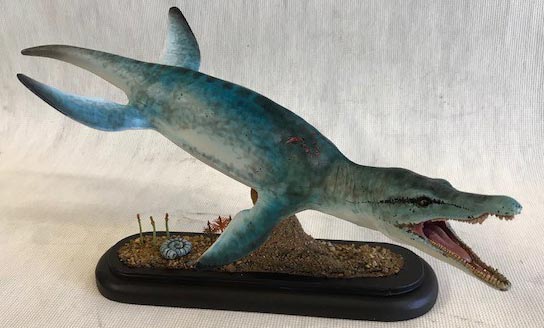
Picture credit: Martin Garratt/Everything Dinosaur.
Explaining the significance of the “Scunthorpe Pliosaur”, Richard Forrest, a vertebrate palaeontologist with an extensive knowledge of the Plesiosauria stated:
“Although the specimen is not complete it tells a fascinating story of how the carcase was broken down by scavenging and decay in the ancient Kimmeridge Clay seas. Because top predators are much less common than their prey, this is indeed a rare find. We have hundreds of specimens of other marine reptiles, but only a handful of Pliosaurs.”
The “Scunthorpe Pliosaur” Goes on Display
The fossils will be on display at the North Lincolnshire Museum in a temporary exhibit, however, there are plans to give this exceptionally rare fossil find from eastern England a permanent home at the Museum.
Richard Forrest Examines the Pliosaur Vertebrae
Picture credit: North Lincolnshire Museum
Councillor Elaine Marper, responsible for the North Lincolnshire Museum added:
“We are over the moon to be able to have this prehistoric sea monster on display at North Lincolnshire Museum. This is a rare find and to have the fossilised remains stay in North Lincolnshire and go on display for the public is a real feat. Thank you to CEMEX for making this possible.”
Richard Forrest at the Quarry Holding the Pliosaur Tooth Discovered at the Site
Picture credit: North Lincolnshire Museum
Everything Dinosaur acknowledges the assistance of a press release from North Lincolnshire Council in the compilation of this article.


